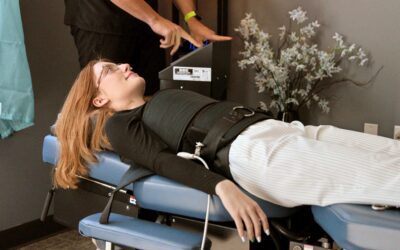With the rise of the digital era, our work patterns have transformed significantly. Prolonged hours spent sitting in front of computer screens have become the norm, with many of us unaware of the detrimental effects this can have on our health, particularly our musculoskeletal system.
Workplace ergonomics are often overlooked, but they can significantly influence your overall health, productivity, and comfort at work by promoting good posture, less repetitive movements, and decreased use of force.
Poor workplace ergonomics can lead to chronic conditions like carpal tunnel syndrome, tendonitis, headaches and other forms of musculoskeletal disorders. Here are ways to set up an ergonomic work station.
Computer Monitor
It’s pretty easy to find yourself slouching over your laptop. When you lean forward, your head is not evenly supported by your spine and neck muscles. This position can lead to tension headaches and neck pain, and contribute to pinched nerves.
Consider investing in a larger monitor so you can work on a big screen instead of squinting at a laptop. The monitor should be about an arms-length away. Your eyes should be level with the monitor.
Laptop
Laptops are convenient to use almost anywhere, but it’s easy to get into bad habits. Avoid using your computer while lying in bed to reduce neck strain. If you sit on a couch and type, buy a laptop desk that fits on your lap. If you work at coffee shops chose a table and chair where you can sit up straight.
Keyboard and Mouse
An ergonomic keyboard is a must for proper shoulder alignment. These are designed to reduce fatigue and misalignment. Basic laptop keyboards can cause you to lean forward, tightening front neck and chest muscles.
Consider investing in a basic ergonomic keyboard, like a wave design. You may also try a split keyboard, which allows you to stretch your shoulder blades out while you type. Some keyboards also have small stands so you can tilt the keyboard at different angles.
There are many ergonomic mouse options, including versions that allow a “handshake” position during use.
Wrist Padding and Mouse Pads
Many people find relief by placing foam padding under their wrists. Some keyboards include a memory foam pad, or you can buy one separately. Invest in a nice mouse pad so you can move your mouse smoothly and reduce repetitive strain.
Chair Position
It’s important to try different office chairs so you can find one that works for your height. Your feet should be flat on the ground. If you need to raise your chair for proper monitor use, put a block under your feet so they are stable.
If your chair does not include enough support, you can place a towel behind your back or buy a pad to improve posture.
Desk
Proper desk height will keep you feeling your best. When you sit at a desk your arms should be close to your sides, and your elbows should be at a 90-degree angle. Your forearms are parallel to the ground and your wrists stay straight.
The same principles apply if you use a standing desk. You can also try a desk with two tiers. One for your keyboard and a higher tier for your monitor.
If you’ve been having issues with carpal tunnel syndrome, tendonitis or a sore neck from less than ideal workplace ergonomics, your chiropractor is a vital ally in your journey towards better workplace health. Chiropractors are experts in diagnosing and treating conditions related to your musculoskeletal system.
They offer valuable insights into posture correction, recommend exercises to strengthen your musculoskeletal system, and provide treatments that help alleviate pain caused by musculoskeletal disorders.
By understanding your specific needs, your chiropractor can guide you to modify your workspace in a way that supports your body’s natural alignment. This could be as simple as adjusting the height of your chair, the position of your computer monitor, or the placement of your keyboard and mouse.
If you’re already experiencing issues related to poor workplace ergonomics, such as back, wrist, or neck pain, your chiropractor can provide targeted treatment. Through spinal adjustments, therapeutic exercises, and various other techniques, they can help reduce inflammation, restore mobility, and alleviate pain. They can also provide valuable advice on exercises and stretches that you can incorporate into your daily routine to maintain your spinal health.
We’re Here To Help
If you’re suffering from joint pain, neck pain or hand and wrist pain and tingling from carpal tunnel syndrome, we can help get your body back to normal. With our therapeutic massage therapy, electric muscle stimulation and spinal manipulation, we can help alleviate the pain and get your joints back to working the way they’re supposed to.
Call 417 Spine to schedule an appointment and start conquering your pain.


